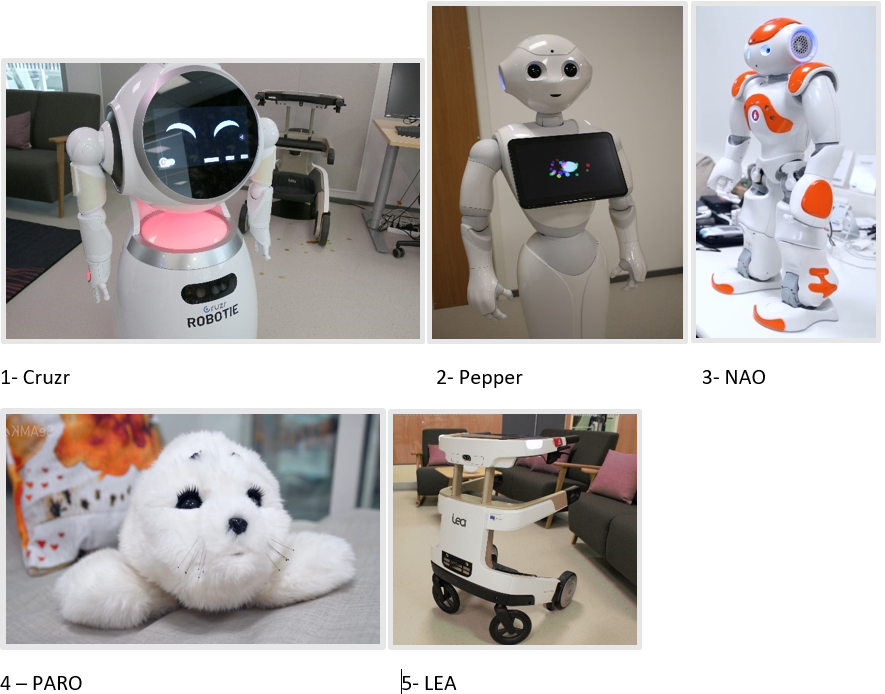ROBOTS: new actors that will help to meet needs of healthcare systems and patients
Author’s note: This article is part of a series published in SeAMK eJournal about cutting-edge technologies (Artificial Intelligence, Big Data, Robotics, and Internet of Things) that will revolutionize the healthcare in the near future.
Current technological advances in communications and electronics have paved the way for robotics to enter in the healthcare field allowing to improve the effectiveness of the treatments and services for different users, namely: patients, clinicians, caregivers, healthcare providers. On the other hand, the growing elderly population as well as the increasing rate of chronic diseases (diabetes, respiratory and cardiovascular diseases, cognitive impairment, etc.) in world-wide developing countries are provoking healthcare demands, as well as a decreasing of Activities of Daily Living (ADL) performance capability in individuals. It is estimated that 190 million of people suffer this latter condition [1], that could affect to their social and emotional well-being. In particular, key problems of the “age-in-place” scenario, in which older adults are willing to live independently at home, are social isolation, dependent living, physical or cognitive impairment, mobility problems, poor health monitoring, lack of recreation, memory problems and fall problems. Therefore, social and healthcare systems are experiencing a set of multivariate challenges that robotics might contribute to cope.
The care settings where robotics can be applied are multiple, starting from long-term environments (home care, nursing homes) to short-term (hospitals, emergencies). In these scenarios, robots can perform different activities as: supporting physical and cognitive therapies for rehabilitation in postoperative or postinjury care; logistics medical activities by transporting medical material; ADL support, medication reminder, fall avoidance, social interaction and companion for elderly; clinical simulation and training for clinicians; caregiver support; unhealthy habits recognition of patients; surgery procedures needed of high precision and ergonomics in fields like cardiology, ophthalmology, otorhinolaryngology, hepatology, neurology; support for hospitalized children or with disabilities, impairments or chronic disease in order to reduce their anxiety, pain and distress, increase their motivation or even connect them to school and friends.[1]–[3].
Healthcare robotics has become one of the fastest growing field of robotics penetrating the fields of traditional medical treatment and healthcare with different kind of robots that can be classified into inside/on body robots like microsurgical robots, robots prostheses, orthoses and exoskeletons; or outside body robots, that are increasingly adopted by users, as mobile robots for patients with highly infectious disease, surgical robots like DaVinci Surgical System [4], Social Assistive Robots (SARs), health monitoring robots, fall detection/prevention robots [5], or rehabilitation robots like LEA [6].
The SARs are the ones that received more attention because of its demonstrated capabilities of maintaining positive social lives of people with health conditions and supporting them in social interaction. SARs can adopt pet or humanoid shapes, being the latter better considered by user, and some examples of them are Paro [7], Nao (one of the most used by children) [8], Pepper [9], Cruzr [10]; all of them along with LEA have been purchased by SeAMK for research and innovation purposes. All studies that identifies markers of social and emotional impact of the utilization of SARs found improved social engagement, and the lowering of measurements of stress and anxiety [11]. For instance, SARs could assist children managing chronic illness through education and encouragement to perform healthy behaviors, help distract children coping with acute medical procedures or provide companionship and comfort; and as a consequence most publications reported positive outcomes, including generally high acceptance and liking by children, parents, medical staff and teachers [2].
Despite the benefits provided by robots, attention should be pay to overcome arisen challenges in order to achieve a fully adoption of robot in clinical routine and user’s daily life. Particularly careful must be about an excessive engagement between robots and individuals (especially cognitive impaired) or unmeet high expectations because some of them feel to have a relationship with their machines and that might provoke a substitution of real social interaction with detrimental effects on their social life and health. Moreover, not only the interaction or usability requirements should be aimed at an average user skills, either health professionals or patients, but also the robot should be seamlessly embedded in social and cultural context and proactively adapted to the health conditions of the user, so to avoid a lack of interest or frustration in their use. Emphasis must be paid on the assumption that robots’ goals is to augment and extend the capabilities of health practitioners and not their displacement or substitution on their workflow. Other key aspect to be considered is the ethics about preserving the user’s autonomy and dignity, as well as security and privacy in user’s information collections by the robot since it must comply the correspondent regulatory requirements of use. In addition, the cost-effectiveness is a factor that decisively will condition the robot adoption since the cost of these machines in several terms (purchasing, maintaining and user training) normally exceed the affordability of an average users or even health systems.
Finally, it is expected that with the integration of novel technology as AI, IoT, Big Data or 5G future healthcare robotics can find its applications in a wider range and more sophisticated medical and healthcare treatment scenarios. Moreover, it is critical that both the research and industrial communities collaborate with the aim at gaining evidence of health robotics benefits.

Figure 1: Robots in SeAMK.
Pedro A. Moreno Sánchez
RDI Expert/ Researcher
PhD, PMP®
Seinäjoki University of Applied Sciences
School of Health Care and Social Work
References
[1] L. D. Riek, “Healthcare robotics,” Commun. ACM, vol. 60, no. 11, pp. 68–78, Oct. 2017, doi: 10.1145/3127874.
[2] J. Dawe, C. Sutherland, A. Barco, and E. Broadbent, “Can social robots help children in healthcare contexts? A scoping review,” BMJ Paediatr. Open, vol. 3, no. 1, Jan. 2019, doi: 10.1136/bmjpo-2018-000371.
[3] S. Balasubramanian, J. Chenniah, G. Balasubramanian, and V. Vellaipandi, “The era of robotics: dexterity for surgery and medical care: narrative review,” Int. Surg. J., vol. 7, no. 4, pp. 1317–1323, Mar. 2020, doi: 10.18203/2349-2902.isj20201057.
[4] “The da Vinci telerobotic surgical system: the virtual operative field and telepresence surgery – Surgical Clinics.” https://www.surgical.theclinics.com/article/S0039-6109(03)00164-6/abstract (accessed Apr. 28, 2020).
[5] M. Shishehgar, D. Kerr, and J. Blake, “A systematic review of research into how robotic technology can help older people,” Smart Health, vol. 7–8, pp. 1–18, Jun. 2018, doi: 10.1016/j.smhl.2018.03.002.
[6] “LEA from Robot Care Systems in production,” Hittech, Jun. 04, 2018. https://hittech.com/en/lea-from-robot-care-systems-in-production/ (accessed Apr. 28, 2020).
[7] “PARO Therapeutic Robot.” http://www.parorobots.com/ (accessed Apr. 28, 2020).
[8] “NAO the humanoid and programmable robot | SoftBank Robotics.” https://www.softbankrobotics.com/emea/en/nao (accessed Apr. 28, 2020).
[9] “Pepper the humanoid and programmable robot | SoftBank Robotics.” https://www.softbankrobotics.com/emea/en/pepper (accessed Apr. 28, 2020).
[10] “Cruzr,” UBTECH Robotics. https://www.ubtrobot.com/products/cruzr (accessed Apr. 28, 2020).
[11] A. A. Vogan, F. Alnajjar, M. Gochoo, and S. Khalid, “Robots, AI, and Cognitive Training in an Era of Mass Age-Related Cognitive Decline: A Systematic Review,” IEEE Access, vol. 8, pp. 18284–18304, 2020, doi: 10.1109/ACCESS.2020.2966819.
[12] Z. Pang, G. Yang, R. Khedri, and Y.-T. Zhang, “Introduction to the Special Section: Convergence of Automation Technology, Biomedical Engineering, and Health Informatics Toward the Healthcare 4.0,” IEEE Rev. Biomed. Eng., vol. 11, pp. 249–259, 2018, doi: 10.1109/RBME.2018.2848518.
[13] E. D. Oña, R. Cano-de la Cuerda, P. Sánchez-Herrera, C. Balaguer, and A. Jardón, “A Review of Robotics in Neurorehabilitation: Towards an Automated Process for Upper Limb,” Journal of Healthcare Engineering, 2018. https://www.hindawi.com/journals/jhe/2018/9758939/ (accessed Apr. 21, 2020).
[14] S. Wan, Z. Gu, and Q. Ni, “Cognitive computing and wireless communications on the edge for healthcare service robots,” Comput. Commun., vol. 149, pp. 99–106, Jan. 2020, doi: 10.1016/j.comcom.2019.10.012.

